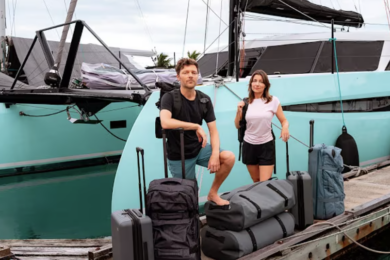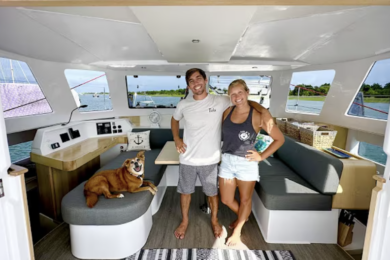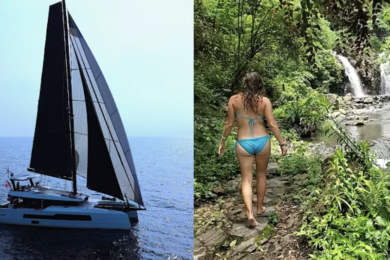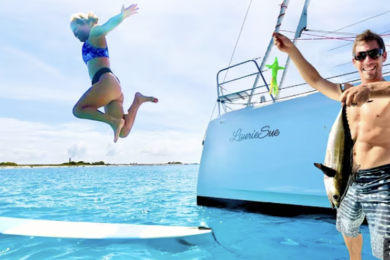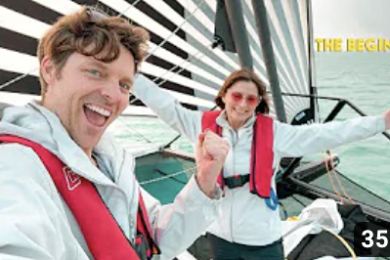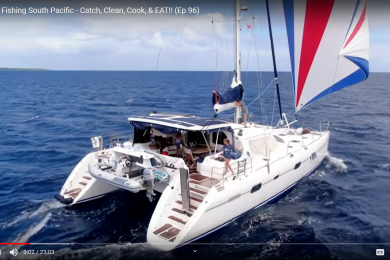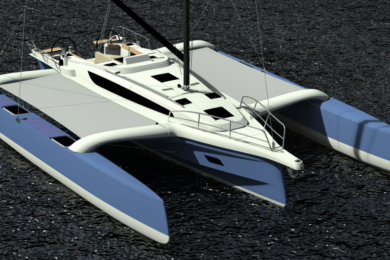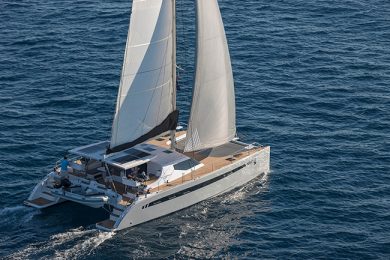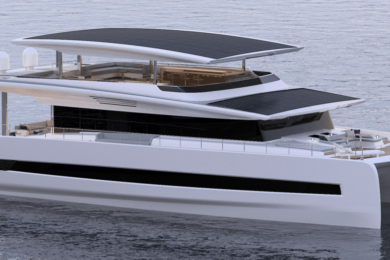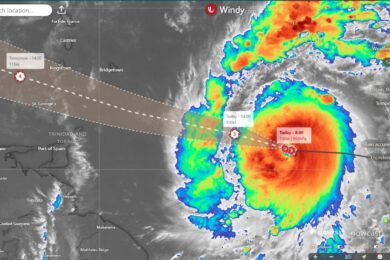
St Francis 50 delivery from Cape Town to Annapolis (Published Spring 2011)
South Africa has numerous catamaran manufacturers that have established a solid reputation in both the cruising and charter world. It is the nature of the business to market one’s product as effectively as possible. As a result, South African catamarans feature prominently at every major boat show worldwide. But being located on the southern tip of Africa has always presented challenges to boat builders. Regardless of the time of year, getting their product to these shows on time and in pristine condition is crucially important. Enter the delivery skipper.
It’s a crisp morning in late July 2010 as this particular delivery skipper watches the massive sliding doors of bay #3 open at St Francis Marine. The latest “Phantom” 50 is wheeled into the elements for the first time. It’s impressive, but there’s no time to admire her just yet. The brand new rig from Southern Spars has just been driven up from Cape Town on the yard’s customized trailer. The rigger is standing by and the clock is ticking. We get straight to work.
As we hoist the mast aloft on the yard’s crane, my phone rings. It’s one of my delivery crew wanting to confirm the trip. I answer the phone. “Ja Bru—get the U.S. Visa sorted for you and your missus. We’ll be in Cape Town in a week or so.”
Three working days later, we are sea trialing off Port St Francis, enjoying an impressive turn of speed. Full main and the new screecher from Quantum have us doing 12 knots in a heartbeat. As we calibrate instrumentation, it appears that all the systems are functioning well. I am happy for the 48-hour shakedown cruise to Cape Town that will follow, but my concerns lie in the Atlantic and beyond.
The Annapolis Boat show runs from October 7-11, 8200 nautical miles from Cape Town. In order to get there, we need to get going. It looks like the hurricane season is going to be a busy one and I’m feeling edgy.
LET THE GOOD TIMES ROLL
Four of us finally left Cape Town on Penelope on the evening of August 12th. Deon and Kat are newlyweds and recently-qualified Yacht Masters who were doing the trip for the miles. Karl is an experienced Yacht Master and acquaintance from the “Stock.” I was confident with my crew, even if we’d only just met.
Carrying an extra 158 gallons of fuel on top of our standard 178 gallons, I was sure of making Trinidad. My logic was to head there first. It’s below the hurricane belt. We could re-victual, then head up through the Caribbean Sea to the Bahamas, where we were to rendezvous with the new owner. I was also carrying an old gennaker from one of the 44s, and I intended to fly it as much as possible, should the conditions suit.
And they did. After 24 hours, we had a 20- to 25-knot southeasterly and hoisted the gennaker aloft. We were still getting to know each other, so I took my time double checking the tack line and sheet leads. Then Deon hoisted the sock as I trimmed on the sheet from the helm station. The gennaker ballooned out in front of us and we took off. I soon realized that this cruising catamaran is designed to perform. Downwind with just the gennaker, we were regularly hitting 15 knots, surfing into the late teens. As I flipped a perfect “easy over” fried egg, we hit a 20 knot surf! Passing a sandwich to Karl at the helm, I thought it impossible for his grin to get bigger, but it did. Thank you Angelo Lavranos!
But all good things must come to an end. The delivery gennaker had been repaired more than once and as we flew along, chewing up the miles, we aptly named it “Patch.” I made a call to keep flying it through the night. The sea was quite big and fairly short, the wind gusting a bit, so in retrospect I should have gotten it down before nightfall. But we had a deadline to meet.
A few hours later while in the head, there was a hammering above. “Patch” had blown—exploded actually! We’d punched into the back of a swell off a16-knot surf. Boat speed dropped to 9 knots and simultaneously the wind had gusted to 30. Poor “Patch” had gone to sail heaven. All hands on deck, we retrieved the tattered sail, furled out the genoa and continued on our way.
I suppose this marked the beginning of an amazing and memorable voyage. But I had no idea then that what lay ahead would be far more serious than I could have imagined.
WAY OUT THERE
The “blue on blue” carries a unique energy. Day in and day out, you progress on your relatively tiny vessel across the vastness of the ocean. The sky above feels massive. There is no cell phone signal. What you could have or should have done before you left is irrelevant. It’s you, the boat, the crew and the elements.
In our case, we traveled in style. All cabins were en suite. We had a huge chest freezer, two fridges, four-plate gas stove, full size oven, microwave, TV, DVD and surround sound. I divided the day into three four-hour watches and the night into four three-hour watches. This works well as the watches roll evenly between sunrise/sunset and the inevitable “dog watch.” The person on the 0800-1200 prepared lunch and did the dishes. The person on the 1200-1600 did dinner. Breakfast was a help-yourself affair.
Aboard Penelope, everybody made a real effort to prepare meals. Food is always a highlight at sea, so when it’s not your turn, you can kick back and enjoy another’s effort. We ate extremely well, baking bread every other day. We caught fish, too, but not as many as we would have liked. We landed only one good-sized Dorado, but the hook pulled out of its mouth as we were getting it up the transom steps. Instead of the fish being gutted, I was! Dorado is my absolute favorite fish to eat.

We sailed practically all the way across the equator, which was amazing. I had received permission from Duncan Lethbridge (owner of St Francis Marine) via satellite phone to use the new gennaker. We had been, but we took it down every night without fail! We dressed Deon and Kat in their foul weather gear on the day we crossed the equator. They sang to Neptune while wrapped in the remnants of “Patch.” As they sweltered, we toasted Mother Ocean with a bottle of Pongracz. Looking up at the gennaker, I pinched myself at how smooth the trip had been so far.
THE ANGRY VIKING
For the Atlantic leg, we were weather routed via satellite phone by Duncan and my brother Pete. Pete is an avid surfer and I couldn’t have wished for anybody better. Duncan, too, was always spot-on.
As we approached the bulge of Brazil, the hurricane forecasts started coming in. It was early September, when hurricanes develop west of the Cape Verde Islands and come screaming across the Atlantic toward the West Indies. Generally, they bend north from there, but as we all know, many don’t, often slamming into the Caribbean Islands, the Bahamas or South Florida. Igor was the first one that we got wind of. Way north of us, it wouldn’t pose any direct problems, but it was scary. As Pete put it, “Igor looks like a hungover Viking who just caught someone in bed with his wife!” We all had a nervous giggle, but the reality was that we were entering “the zone.”
With Igor to the north, I decided to tuck in behind it and head straight for St Lucia. After 32 days at sea, the Pitons’ familiar silhouette greeted us at dawn. Land holds an unusual smell after being at sea for a month. I breathed in its earthy sweetness with satisfaction. It had been a long haul, but leg one was over.
Ideally, I would have liked to stay for two days, but swells from Igor were smashing into the Bahamas and I knew it would be a very uncomfortable ride. As it turned out, we stayed for four, long enough to enjoy some wonderful St. Lucian hospitality and experience the famous Gros Islet street party. The boat was in great shape, and after taking on some fresh produce and diesel we set off towards the Bahamas.
BIG AND CONFUSED
Conditions were favorable and we made good time with the screecher, logging a few 190nm days. Nighttime was always a little unsettled, with squalls forming quickly. Under clouds we were getting 35+ knots of wind. Lots of lightning, too, but never too close. The water temperature was 35 degrees centigrade—ideal hurricane conditions.
After six days, we arrived at St. Francis Resort on Stocking Island, where we were welcomed by George Godfrey and his family. Leg two was over. The few days there were spent enjoying crystal clear waters and evening games of poker with the locals.
We were constantly keeping an eye on the weather, as there was lots of activity south of Cuba. Tropical storm Nicole was developing and starting to head north. Our time was running short, with winds forecast to go north off Cape Hatteras in a few days. Risking stiff breeze on the nose against the Gulf Stream was not really an option. If we didn’t go now, we’d probably miss the Boat Show. So we left in a hurry trying to duck in underneath the advancing Nicole.
The first few days out of the Bahamas, we tried to go as quickly as possible. We had a short eight-foot beam sea and the wind was gusting between 13 and 25 knots. The gennaker wasn’t an option, so we motorsailed, averaging just under 10 knots for 48 hours. But the remnants of Nicole were traveling faster, and 300 miles south of Cape Hatteras things started getting interesting.
Please note that I use the word “remnants,” because that is what it was. The storm was dissipating when it came over the top of us, but it still wasn’t pretty. We had furled the jib away to about four square meters. The wind, now on the starboard quarter, was regularly hitting 40 knots. The sea was big (about 20 feet) and confused. Every now and then, a nasty one would feather, then smash into the starboard hull, causing the boat to twitch a bit. We’d received our last forecast and I knew that the next 24 hours were going to be tough.
BOAT GRAVEYARD
The following morning, the wind rose above 40 knots and stayed there. I felt a little knot of fear start building inside. I let it come, recognized it for what it was and remained calm. Calling on logic, I started ticking mental boxes. The boat was handling beautifully. We’d taken a few waves, but not a leak anywhere. Nothing was broken. All systems were functioning. We were doing 9 to 10 knots and surfs were under control. The rig was rock solid and the boat didn’t feel over powered. The crew was much quieter than usual, but calm and ready. Our course was okay and it looked like we’d be able to round Cape Hatteras by nightfall.
Feeling better, I glance behind at the approaching squall. We register 53.7 knots of wind. The familiar knot returned just as Kat appeared with a sandwich. I tucked into it and the knot disappeared…it must have been a hunger pang!
We had wisely stayed far offshore after leaving the Bahamas, so we were able to head north and keep the wind on the starboard quarter during the entire storm. The decision to stay offshore made rounding Cape Hatteras a lot less difficult than it might have been. We approached late that afternoon, Karl at the helm and me navigating.
I understood that when we rounded and started heading towards the Chesapeake, we would be in very shallow water and had concerns of breaking waves. Looking at the graveyard of wrecks on the chart, I decided to keep “pinching,” trying to come up a bit higher, until we were about 15 miles past the point. We could then turn in about 115 feet of water as opposed to 65. I’ll never forget the look on Karl’s face as he kept pinching higher, helping us get to that deeper water. He was completely focused and absolutely resolute in doing what needed to be done. He’d been rock solid as a first mate the whole trip and never missed a beat.
Just before nightfall, I made the call to come to port. The wind was directly astern and the seas still large. It was blowing 40+ knots and very dark. We would hear the waves before we saw their frothing crests looming high above the stern light. Next thing we knew, we’d be screaming down the face, watching our boat speed rocket. Each time, Penelope came out beautifully. Our top surf with Deon on the helm was 25.7 knots!
Rapidly approaching the Chesapeake with the storm showing little sign of abating, we furled away the “G string” and continued to hit 17-knot surfs under bare poles. In the small hours of the morning, the wind suddenly dropped. The storm had passed and within an hour we had 20 knots on the nose.
LAND HO!
We arrived in Norfolk, VA early in the morning. U.S customs were friendly and efficient, arriving within half an hour of my call.
All checked in, we were too amped to sleep and after a clean up, we headed downtown. Back in South Africa, Duncan was relieved that all was well. He generously suggested that I take the crew out for a well deserved meal on him. Kat and Deon, enjoying some husband and wife time, arranged to meet Karl and me for dinner a bit later. It felt surreal walking around town. At sunset, Karl and I stumbled across a reggae band playing music in a park adjacent to the Marina. Their name? Destination. We had a good chuckle, kicked off our shoes and got into it. The unfamiliar feeling of grass between my toes felt very good indeed.

A few days later, we arrived in Annapolis, where we set to work detailing the boat before the show. Soon, all the stainless on deck had been polished and after a detailed wash down, the exterior was looking like a brand new boat again. The interior had been extremely well protected for the trip. We removed floor runners to expose gleaming teak floorboards and took the protection off the Corian tops and settee covers off the leather. Windows were windexed, stainless steel sinks buffed and all the paraphernalia from the crossing stowed.
I had gotten to know the St Francis 50 intimately on the way across and had been very impressed with how little had gone wrong and how magnificently she had handled. Looking over the vessel one last time as the show was about to open, I fully appreciated what a fantastic, proudly South African product this was.
Stephen Praetorius is a proud South African yachtsman who—after hitching a ride from Cape Town to Antibes—spent a decade working on classic yachts in Europe and the West Indies. Since returning to Cape Town and going land-based, delivering boats keeps life in perspective. After 11 Atlantic crossings and more than 60,000 nautical miles, life at sea is as challenging and exciting as ever. “Being out there is spiritual. It brings humility and appreciation for all the things that we too often take for granted.”

